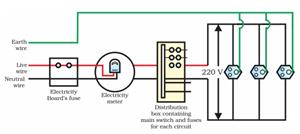
PUMPA - SMART LEARNING
எங்கள் ஆசிரியர்களுடன் 1-ஆன்-1 ஆலோசனை நேரத்தைப் பெறுங்கள். டாப்பர் ஆவதற்கு நாங்கள் பயிற்சி அளிப்போம்
Book Free DemoIn our homes, we receive a supply of electric power through the main supply (also called mains), either supported through overhead electric poles or underground cables. One of the wires in this supply, generally with red insulation cover, is called live wire (or positive). Another wire with black insulation is known as neutral wire (or negative). In India, the potential difference between the two is \(220\ V\).
At the metre-board in the house, these wires pass into an electricity meter through the main fuse. Through the main switch, they are attached to the line wires in the house. These wires provide electricity to separate circuits within the house. Usually, two separate circuits are used, one of \(15\ A\) current ratings for appliances with higher power ratings such as electric heaters, geysers, air coolers, microwaves, etc., the other circuit is of \(5\ A\) current rating for bulbs, fans, televisions, radios, etc.,
Important!
Current rating:
The current rating is the maximum current that a fuse will carry for an indefinite period without the fuse element's deterioration.
The earth wire, which has green colour insulation, is generally attached to a metal plate deep in the earth near the house. This is used as a safety measure, particularly for appliances with a metallic body, for example, electric press, microwave, toaster, table fan, refrigerator, etc. The metallic body is attached to the earth wire, which provides a low-resistance conducting path for the current. Thus, it assures that any leakage of current to the metallic body of the appliance keeps its potential to that of the earth, and the user may not get a severe electric shock.

A schematic diagram of one of the common domestic circuits
The above diagram shows a schematic diagram of one of the standard domestic circuits. Separate appliances can be attached across the live (positive) and neutral (negative) wires in each separate circuit. The flow of current through each appliance is controlled (ON/OFF) by separate switches. Each appliance has an equal potential difference, and they are connected parallel to each other.
An electric fuse is a crucial component of all domestic circuits. In the previous chapter, we have already studied the principle and working of a fuse. A fuse in a circuit prevents damage to the electrical appliances and the circuit because of overloading.
Overloading can happen when the live wire and the neutral wire come into direct contact. (This happens when the insulation of wires is damaged or there is a defect in the appliance.) In these situations, the current in the circuit suddenly increases. This is called short-circuiting.
The electric fuse prevents the electric circuit and the appliance from possible damage by preventing excessively high electric current flow. The Joule heating that takes place in the fuse melts it to break the electric circuit. Overloading can also happen due to an accidental hike in the supply voltage. Sometimes overloading is caused by connecting too many appliances to a single socket.
The precautions that should be taken to prevent the overloading of domestic circuits:
- Two different circuits should be used, one of \(5\ A\) current and the other \(15\ A\) current.
- For both \(5\ A\) and \(15\ A \) circuits, we should install the fuse.
- Parallel circuits should be used.
- Never connect too many electrical appliances at the same point.
- Never use too many electrical appliances at the same time.
- We should not connect damaged appliances in the circuit.